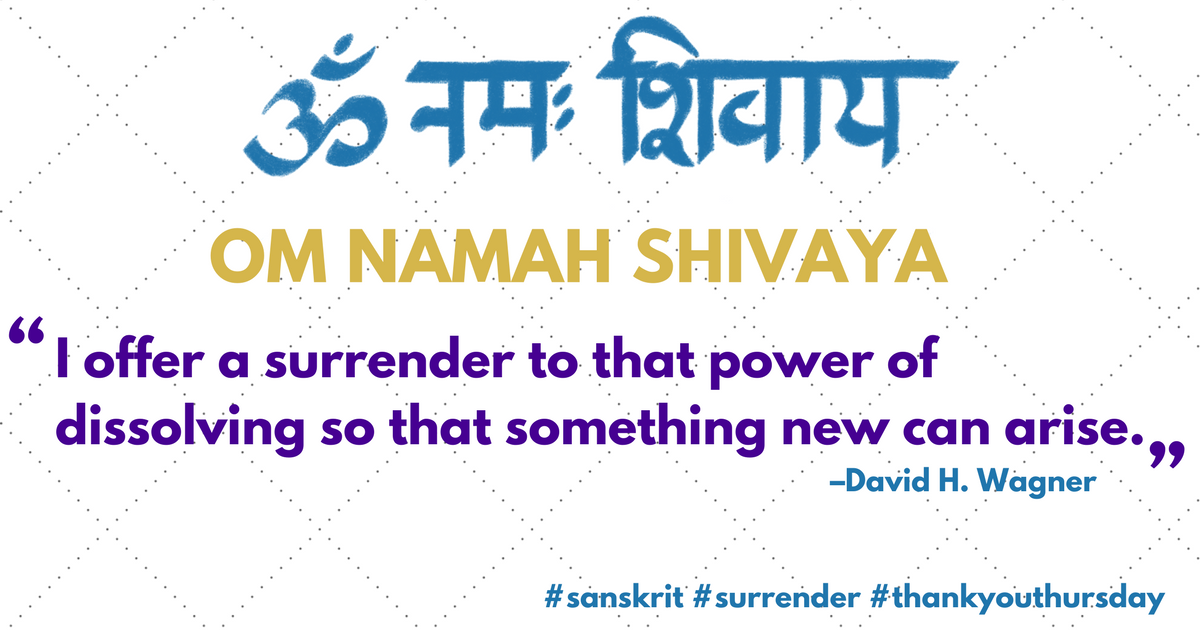When I decided to start learning Sanskrit, I figured it would be hard. I assumed it would be worthwhile. I had no idea that Sanskrit surrender would bring me to my knees, shaking with total release.
And I am so glad it did.

Why I decided to learn Sanskrit
I love to sing.
I especially love to sing as a form of worship—the hymns are always my favorite part of church.
So I love that praise-singing is part of yoga.
Specifically, as part of the bhakti yoga tradition (aka the yoga of devotion), it is common to chant mantras to music.
This musical chanting is called kirtan, and it’s a whole “thing” in the music and yoga worlds.
Alanis Morrisette’s twin brother performs kirtan; a former backup singer of Madonna’s performs kirtan.
Kirtan comes in many styles and forms, some of which incorporate English—and all of which emphasize Sanskrit.
I’ve been enjoying kirtan off and on since 2005, so I’ve naturally picked up some common phrases and mantras along the way.
But I’ve never REALLY understood just exactly what the words meant.
And although prayer and worship are more about energy than words, I also think it’s nice to know what you’re saying.
So I signed up to learn Sanskrit.
You don’t need to learn Sanskrit
Three classes in, take my word for it: you don’t need to learn Sanskrit.
It is a beautiful language that reminds me somewhat of Latin. Its structure is simple, but its implementation is complex.
And while it’s definitely worth studying if you have the time—and I do mean a LOT of time—the benefits are accessible without the scholarship.
All you need is a willingness to listen and repeat.
Each syllable of Sanskrit is said to have a sacred frequency, which is why chanting Sanskrit mantras, even if you don’t understand them, can raise your vibration and affect you energetically.
In other words, because Sanskrit is considered to be a sacred language, simply hearing and speaking its sounds can enlighten you.
A little Sanskrit goes a long way
I’m probably not going to keep up with my Sanskrit classes.
It turns out that learning the alphabet and how to properly pronounce all the sacred syllables is about all I have room for right now.
But what I did learn paved the way for an astonishing experience.
Because it’s true that you don’t have to understand Sanskrit to benefit from its vibrations. But if you do know exactly what you are saying, the energy is even more powerful.
Om Namah Shivaya FTW
I’ve always liked the mantra “om namah shivaya,” but now that I understand it more fully, it has become a lifeline.
Om = the primordial sound—you can basically say ONLY this syllable and still completely attune with your understanding of god/the universe/whatever.
Namah = to offer respect—also translated as “to bow” (BTW this is where “namas te” comes from…and yes, it is two words, not one, which totally blew my mind.)
Shivaya = the power of transformation—aka Shiva, the Hindu god of destruction (but, like, destruction in a good way, because nothing new can be created until the old is cleared)
I learned a bit about each of these syllables in Sanskrit class, and then last Thursday night I had the impulse to take a yogaglo.com class from my favorite meditation teacher, David H. Wagner.
He defined the mantra in several ways, including this translation:
“I offer a surrender to that power of dissolving so that something new can arise.”
And then we sat and inwardly chanted “om namah shivaya” for, like, thirty minutes straight.
I’d never done that before.
And I don’t know if it was David’s excellent guidance or my newly heightened awareness of the Sanskrit language or my extreme willingness to LET GO, FOR REALZ, but, whatever it was, that meditation WORKED.
I started out resistant, burst into tears, softened my heart, melted into the floor, and by the end I had shaking hands and full-body tremors.
Mid-meditation, I jotted down this…poem?
om namah shivaya
I am vibrating
my body is booming
breath is intentional deliberate
an effort
a release
a quiver
a shake
a labor
a gift
And then the meditation was done, and I finished up with this:
I feel so humbled and thankful. I am still afraid, like a trembling child, but I also know that my parent is near. I am so deeply cared for; a power much greater than “me” is present. Can I be brave enough to let it flow through me with increasing intensity?
I can be brave enough to surrender, and so can you
True surrender takes a crazy amount of courage.
However, in my experience, letting go is always worth it, and we can be brave.
For better or worse, words can’t adequately describe my om namah shivaya meditation experience.
But my gratitude for the experience is nonetheless immense, and I’d like to offer a similar relief to you.
Of course chanting Sanskrit isn’t for everyone, and that’s cool. There are lots and lots of ways to connect to god/the universe/whatever.
Sanskrit surrender as a song (or ten)
But if you’re curious about kirtan, FYI that there is a TON of it available for online listening.
For example, when I did a search on Spotify for “om namah shivaya,” there were literally hundreds of results.
So I took the liberty of compiling a few of my favorites into a playlist, aptly titled Surrender:
Exploring sacred sounds is not the answer to everything, but I’ve certainly found it to be a helpful start. And maybe you will, too.
Love > fear,
![]()

